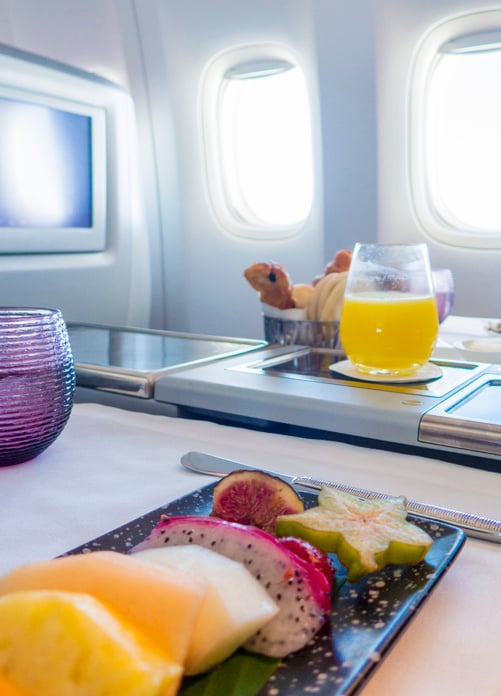Which plane are you on?
(Blog written by Dave from Upgrade Your Travel Life – aviation geek)
Did you know the weekend (9 February 2019) marked the 50th anniversary of the first flight of the Boeing 747? Being bigger than any other passenger plane at the time and able to fly vast distances, it opened up the world of travel to everyone. It brought down prices and made travel easier and more affordable than ever before, while providing a whole new level of comfort.
When my friends and family fly, many of them pay little attention to the plane they are on. They simply book a flight with an airline they know, at a good price, on the days they want to fly. And while there is nothing wrong with doing this, understanding the type of plane you are on can have benefits. Spending a few more minutes researching the actual type plane you will fly on can make a difference to your comfort and the quality of your meals.
A great example is Emirates… did you know Emirates flies two main types of plane, the Boeing 777 and the Airbus A380. Usually the tickets cost the same no matter which plane you are on (on the same route), but in almost every class you will be far more comfortable on the A380. Fly business class on the 777 and you may get a dreaded middle seat and have to step over someone, however fly the A380 however and there are no middle seats, you will get direct aisle access. You can also enjoy a delightful drink at the stand-up bar to break up the journey.
Flying economy? Well both planes have 10 seats across and two aisles, but the cabin on the A380 is a full 0.7m wider than a B777, which translates into all-important extra space on the plane. The A380 is also much quieter than the B777 – I know which plane I’d rather be on!
Planes also come in “narrow” and “wide” body, a narrow body generally has one aisle and wide body has two aisles.
Type of plane and meals
Why am I talking about this? Well this can make a big difference to your morning coffee for example. Take Qantas – on most wide body Qantas aircraft there are espresso machines fitted in business. Flying on a narrow body? Well I hope you like instant or plunger coffee… certainly no espresso or cappuccino for you while in the air! Often the airline schedules both types of planes, especially for domestic flights, or short haul international, so choose wisely!
Of course, larger planes can fit in bigger galleys. This means the food and drink offered usually has more variety. Also flying on an aircraft with two aisles means more flexibility in the way food is served. It is not necessarily just served on a tray from the cart, but in some classes it means food can be served individually to you and sometimes more freshly prepared. It may also mean service could be faster as the crew are not constrained by trolleys blocking the aisle. All wins in my book!
Now you might be thinking well I only fly domestically so I won’t be flying a big plane, but many airlines also use their long haul international configured aircraft on domestic sectors usually during the day when the aircraft is not scheduled for its next intercontinental flight. For example, Finnair frequently use their A350s which fly in from Asia, to operate an intra-European sector between Helsinki and London, and back again. British Airways do something similar with their B777 aircraft which you will find will also do a short hop from London to Madrid, and Air New Zealand similarly offer B777 and B787 aircraft between Australia and Auckland, alongside their regular A320 narrow body workhorse. These aircraft have been set up for long haul flying and offer an increased level of comfort and amenity in all cabins, especially when compared to the narrow body A320s and B737s otherwise routinely used.
So why is this important to consider? It’s the equivalent of taking a Rolls Royce vs your stock standard Ford! By picking flights operated by these long-haul configured aircraft, not only do you get the benefits of an international flight such as wider range of movies, bigger screen, and a flat-bed in business, but you will also likely enjoy a better range of food and drinks, more freshly prepared and often presented better, all courtesy of experienced long haul cabin crew with the ability to leverage that larger galley and the space of this bigger plane. And getting a little techy, some newer planes like the A350 and B787 have a “lower cabin altitude”. Not only is this supposed to assist with reducing flight jet lag, but it’s also suggested high altitude and rarified air negatively affects the taste buds. What does this all mean? It is suggested your food will taste better on a B787 or A350!
So, next time you are traveling for work, or pleasure, pay attention to what sort of plane you will be on, even on the same airline, and choose accordingly. It probably won’t make any difference to the price you pay but it will make all the difference to your comfort and the quality of your meals. If you are not sure, then ask an aviation geek or an industry insider. Remember, not all planes are created equal!

A note from Mel, a big thank you to Dave for writing this blog for Nutted Out Nutrition. This is just one example of how taking note of some of the details of your flights can help you plan out your meals and food intake. Understanding more about what the food may be like on your flight can help you decide how much to eat in the lounge or airport before you travel, or whether you should ask your friends or family to have dinner waiting for you at home. So why it may seem like a small detail to you – it can mean a lot to you health overtime. This is just one example of what we may talk about in travel nutrition sessions. If you are interested in learning more don’t hesitate to contact me.



